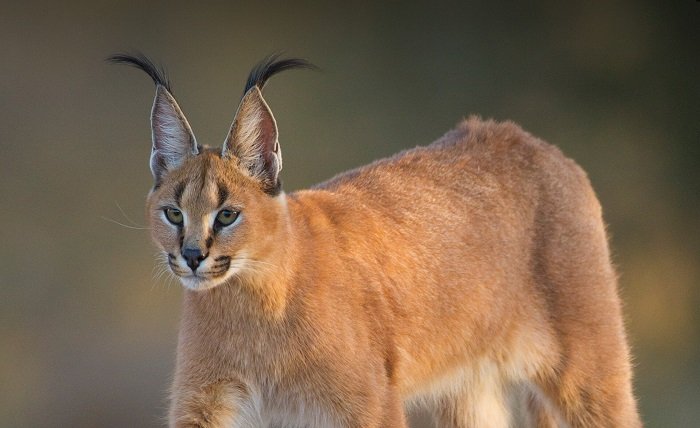The Caracal Cat: Mystique of the Desert

The caracal cat, often simply known as the caracal, is a captivating and enigmatic creature that roams the arid regions of Africa and parts of Asia. This blog post delves into the world of the caracal, exploring its unique characteristics, behavior, habitat, and the challenges it faces in the wild. With a sleek body, distinctive tufted ears, and impressive hunting skills, the caracal is a symbol of the wild’s mysterious beauty and resilience.
The caracal cat is a medium-sized wild cat native to Africa, the Middle East, Central Asia, and India. Known for its striking features and agility, the caracal is often recognized by its sharp, pointed ears topped with long black tufts. These cats are superbly adapted to a solitary life in varied environments, from savannas and forests to arid deserts. Understanding the caracal begins with recognizing its role in the ecosystem as a skilled predator and a key species in maintaining the balance of its habitat.
Physical Description
The caracal cat boasts a robust build with long legs and a short, sleek fur coat that ranges in color from a tawny-beige to a reddish-brown. Adults can weigh between 12 and 18 kilograms and measure up to 42 inches in length, not including their tail. One of the most distinctive features of the caracal is its large, pointed ears which it uses to detect prey even in dense brush. These physical attributes not only contribute to its beauty but also its efficiency as a hunter.
Habitat and Distribution
Caracals have a wide range but prefer environments that offer both cover and open spaces. They are typically found in savannas, woodlands, and semi-desert regions. The adaptability of the caracal cat to various habitats is impressive, allowing it to survive in areas with minimal water. Despite their wide distribution, caracals are elusive and primarily nocturnal, which makes them difficult to spot in the wild.
Diet and Hunting Techniques
Caracal cats are carnivorous and highly skilled hunters. They primarily feed on small to medium-sized mammals, such as rodents, birds, and antelopes. The caracal is renowned for its ability to leap into the air to catch birds in flight, a testament to its incredible agility and precision. This hunting technique highlights the caracal’s role in controlling the population of its prey species, thus maintaining a healthy ecosystem.
Breeding and Lifecycle
Caracals reach sexual maturity around one year of age and can breed any time of the year. The gestation period lasts approximately 78 days, resulting in a litter of one to four kittens. In the wild, caracals are solitary except during mating or when mothers are raising their young. Understanding the lifecycle of the caracal cat is crucial for conservation efforts, as it helps in managing their population in the wild.
Conservation Status
The caracal cat is currently listed as ‘Least Concern’ by the IUCN Red List, but its population is believed to be declining. Habitat loss, human-wildlife conflict, and illegal pet trade pose significant threats to the caracal’s survival. Conservation efforts are essential to ensure that future generations may also witness the beauty of this remarkable wild cat in its natural habitat.
Caracal and Human Interactions
Historically, caracals have been tamed and used for hunting in India and Iran. Today, they sometimes come into conflict with humans when they prey on livestock. Mitigating these conflicts and fostering a coexistent environment are vital for the conservation of caracals. Education and community-based conservation programs can help reduce the negative perceptions of caracals.
Behavioral Traits
Caracals are known for their secretive and solitary nature. They mark their large territories with urine and claw marks to keep other caracals at bay. The nocturnal habits of caracals are a marvel for biologists, as these traits enhance their ability to be effective nocturnal hunters. Understanding these behaviors is key to appreciating how caracals have adapted to the challenges of their environment.
The Role of Caracals in Ecosystems
As apex predators, caracals play a crucial role in the health of their ecosystems. By controlling the populations of smaller mammals and birds, they help maintain a balanced food chain. This role of the caracal cat is often underestimated but is vital in ecological research and conservation strategies.
Challenges in Caracal Conservation
The main challenges facing caracal conservation include habitat degradation, illegal hunting, and the exotic pet trade. Increasing human populations and agricultural expansion also lead to loss of habitat. Conservationists are working to address these challenges through legal protection, habitat restoration, and education programs aimed at local communities.
Future Prospects for Caracal Cats
The future of the caracal cat depends largely on effective conservation strategies and the willingness of local communities to engage in wildlife protection. Continued research and monitoring are crucial to understand the changing dynamics of caracal populations and to adapt conservation efforts accordingly.
Conclusion
The caracal cat remains one of the most fascinating yet understudied animals in the wild. With their graceful presence and formidable hunting skills, caracals symbolize the raw beauty and complexity of nature. Efforts to preserve their habitat and reduce human-wildlife conflict are essential for their survival and for the health of the ecosystems they inhabit.
FAQs
1. What does “caracal” mean?
- The name “caracal” comes from the Turkish word “karakulak,” which means “black ear.”
2. Can caracal cats be domesticated?
- While caracals have been tamed in some cultures, they are wild animals and do not domesticate like typical household cats.
3. How long do caracal cats live?
- In the wild, caracals can live up to 12 years, while in captivity they may live up to 17 years.
4. Are caracal cats dangerous to humans?
- Caracals are generally not dangerous to humans unless provoked or threatened.
5. How can I help in the conservation of caracal cats?
- Supporting wildlife conservation organizations, promoting habitat protection, and raising awareness about the caracal cat are excellent ways to contribute to their conservation.





